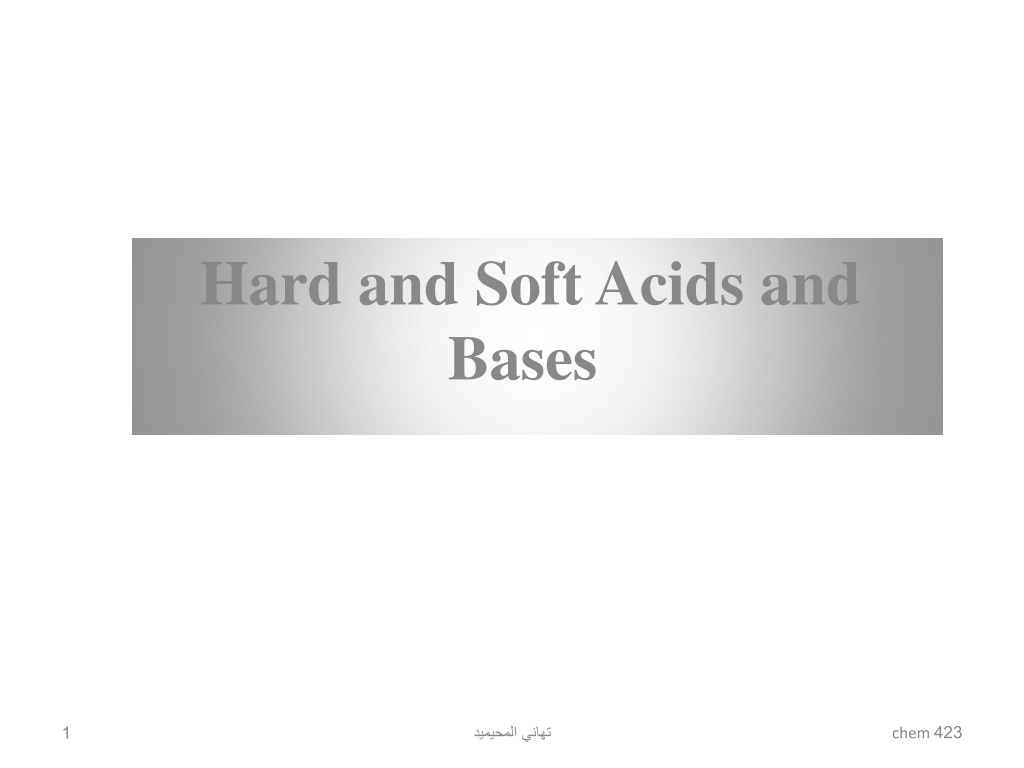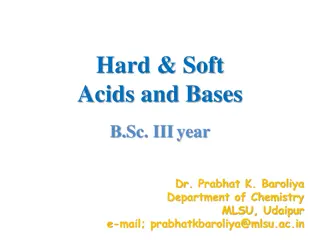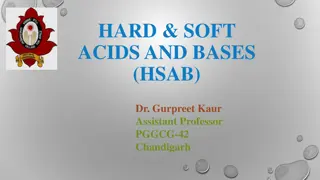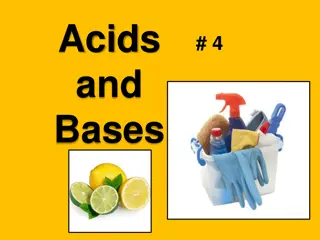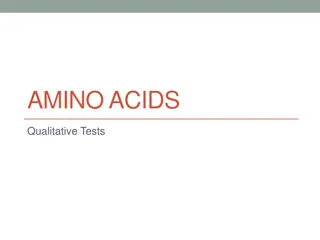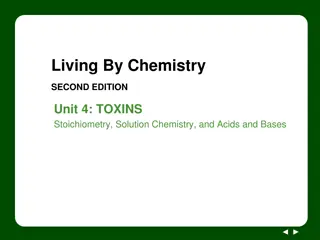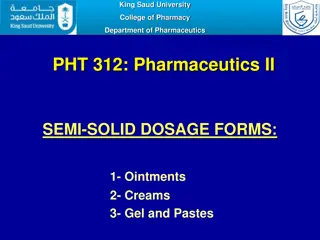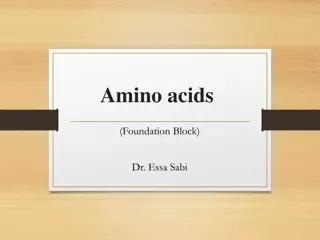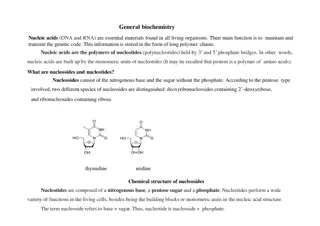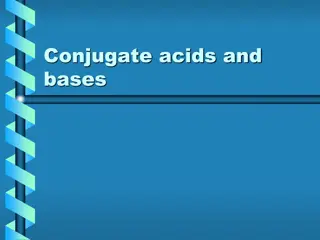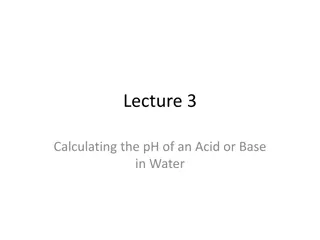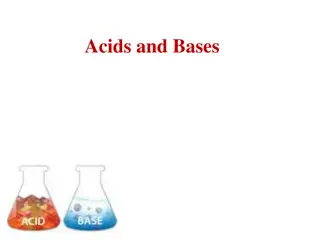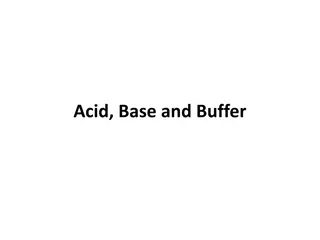Understanding Hard and Soft Acids and Bases Theory
Dive into the world of Hard and Soft Acids and Bases (HSAB) theory which explains the interaction preferences between acids and bases based on their properties. This theory enhances our understanding of chemical reactions, helping predict favorable outcomes and shed light on reactions that classic theories struggle to explain.
Download Presentation

Please find below an Image/Link to download the presentation.
The content on the website is provided AS IS for your information and personal use only. It may not be sold, licensed, or shared on other websites without obtaining consent from the author. Download presentation by click this link. If you encounter any issues during the download, it is possible that the publisher has removed the file from their server.
E N D
Presentation Transcript
Hard and Soft Acids and Bases 423 1 chem
Hard and Soft Acids and Bases Lowry-Bronstead Concept An acid is a proton donor and a base is a proton acceptor. Weak acids in solution exists as an equilibrium mixture of the undissociated acid and the ions formed by dissociation. In an acid base reaction, the equilibrium is always in favor of the weak acid and weak base. * In the above equilibrium, it would be in favor of acetic acid and water because acetate and hydronium ion are stronger base and acid. 423 2 chem
Hard and Soft Acids and Bases Lowry-Bronstead Concept But: the theory cannot explain features of certain reactions HgCl2 + H2S ---> 2HCl + HgS The above reaction takes place spontaneously and the reaction is almost complete. This means it is in favor of the product side which include a strong acid and a strong base. This can be explained by using the Hard and Soft Acid Base theory (HSAB theory). 423 3 chem
Hard and Soft Acids and Bases Hard and Soft Acids and Bases 1965- Ralph Pearson introduced the hard-soft-acid-base (HSAB) principle. Hard acids prefer to coordinate the hard bases and soft acids to soft bases According to this theory a soft acid will react with a soft base more easily. Similarly a hard acid will react with a hard base. Hg2+is a soft acid and S2-is a soft base. So interaction between these two takes place very easily. HgCl2+ H2S ---> 2HCl + HgS 423 4 chem
Hard and Soft Acids and Bases Hard and Soft Acids and Base This concept is classified into hard, soft and borderline acids bases. Hard acids and bases have a tendency to form ionic bonds while soft ones form covalent bonds. Interactions between soft acid and soft base or hard acid and hard base are more effective. HSAB theory endeavors to help one decide if AB + CD AC + BD goes to the left or the right (also helps you to know if AB + CD forms AC + BD or AD + BC) 423 5 chem
Hard and Soft Acids and Bases Acid Base (The acceptor atoms ) (The donor atoms ) Hard acids and hard bases tend to have: small atomic/ionic radius high oxidation state low polarizability high electronegativity energy low-lying HOMO (bases) or energy high-lying LUMO (acids). Hard *The affinity of hard acids and hard bases for each other is mainly ionic in nature. Soft acids and soft bases tend to have: large atomic/ionic radius low or zero oxidation state high polarizability low electronegativity energy high-lying HOMO (bases) and energy-low lying LUMO (acids). Soft *The affinity of soft acids and bases for each other is mainly covalent in nature. 423 6 chem
Hard and Soft Acids and Bases Acids Bases hard soft hard soft CH3Hg+, Hg2+, Hydronium H+ Mercury Hydroxyl OH- Hydride H- Hg22+ Alkali metals Li+,Na+,K+ Platinum Pt2+ Alkoxide RO- Thiolate RS- Titanium Ti4+ Palladium Pd2+ Halogens F-,Cl- Halogens I- Chromium Cr3+,Cr6+ Silver Ag+ Ammonia NH3 Phosphine PR3 Boron BF3 borane BH3 Carboxylate CH3COO- Thiocyanate SCN- trifluoride carbon monoxide Carbocation R3C+ P-chloranil Carbonate CO32- CO bulk Metals M0 Hydrazine N2H4 Benzene C6H6 Gold Au+ Table 1. Hard and soft acids and bases 423 7 chem
Hard and Soft Acids and Bases 423 8 chem
Hard and Soft Acids and Bases 423 9 chem
Hard and Soft Acids and Bases 423 10 chem
Hard and Soft Acids and Bases 423 11 chem
Hard and Soft Acids and Bases Example: a given base, B, may be classified as hard or soft based on the equilibrium: BH++ CH3Hg+ CH3HgB++ H+ There is a competition here between the acid H+and CH3Hg+. If B is soft then to the right If B is hard then to the left Important to remember that the listings in the tables do not have a sharp dividing line between them. These terms, hard & soft , are relative. Some are borderline and even though within the same category are not all of the same degree of hardness and softness e.g. although all alkali metals in ionic form M+are hard , the larger, more polarizable, Cs+ion is much softer than Li+ 423 12 chem
